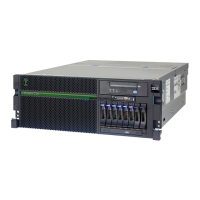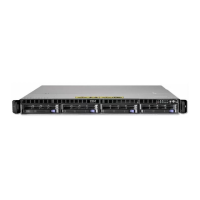Chapter 3. Virtualization 117
Virtual SCSI
The POWER Hypervisor provides a virtual SCSI mechanism for the virtualization of storage
devices. The storage virtualization is accomplished using two paired adapters:
A virtual SCSI server adapter
A virtual SCSI client adapter
A Virtual I/O Server partition or an IBM i partition can define virtual SCSI server adapters.
Other partitions are
client partitions. The Virtual I/O Server partition is a special logical
partition, as described in 3.4.4, “Virtual I/O Server” on page 134. The Virtual I/O Server
software is included on all PowerVM editions. When using the PowerVM Standard Edition and
PowerVM Enterprise Edition, dual Virtual I/O Servers can be deployed to provide maximum
availability for client partitions when performing Virtual I/O Server maintenance.
Virtual Ethernet
The POWER Hypervisor provides a virtual Ethernet switch function that allows partitions on
the same server to use fast and secure communication without any need for physical
interconnection. The virtual Ethernet allows a transmission speed up to 20 Gbps, depending
on the maximum transmission unit (MTU) size, type of communication and CPU entitlement.
Virtual Ethernet support began with IBM AIX Version 5.3, Red Hat Enterprise Linux 4, and
SUSE Linux Enterprise Server 9, and it is supported on all later versions. For more
information, see 3.4.10, “Operating system support for PowerVM” on page 146. The virtual
Ethernet is part of the base system configuration.
Virtual Ethernet has the following major features:
The virtual Ethernet adapters can be used for both IPv4 and IPv6 communication and can
transmit packets with a size up to 65,408 bytes. Therefore, the maximum transmission unit
(MTU) for the corresponding interface can be up to 65,394 (or 65,390 if VLAN tagging is
used).
The POWER Hypervisor presents itself to partitions as a virtual 802.1Q-compliant switch.
The maximum number of VLANs is 4096. Virtual Ethernet adapters can be configured as
either untagged or tagged (following the IEEE 802.1Q VLAN standard).
A partition can support 256 virtual Ethernet adapters. Besides a default port VLAN ID,
the number of extra VLAN ID values that can be assigned per virtual Ethernet adapter is
20, which implies that each virtual Ethernet adapter can be used to access 21 virtual
networks.
Each partition operating system detects the virtual local area network (VLAN) switch
as an Ethernet adapter without the physical link properties and asynchronous data
transmit operations.
Any virtual Ethernet can also have connectivity outside of the server if a layer 2 bridge to a
physical Ethernet adapter is set in one Virtual I/O Server partition (see 3.4.4, “Virtual I/O
Server” on page 134, for more details about shared Ethernet), also known as Shared
Ethernet Adapter.
Adapter and access: Virtual Ethernet is based on the IEEE 802.1Q VLAN standard. No
physical I/O adapter is required when creating a VLAN connection between partitions, and
no access to an outside network is required.
